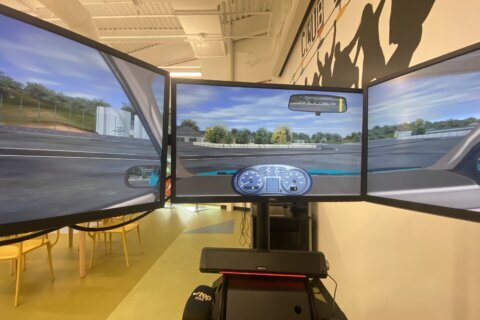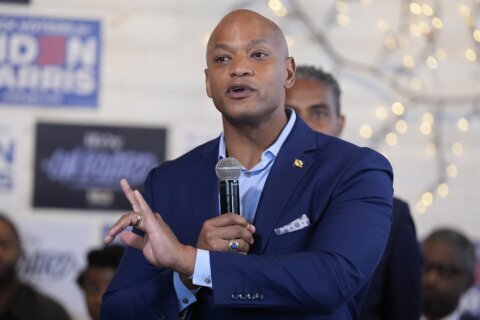This article was republished with permission from WTOP’s news partners at Maryland Matters. Sign up for Maryland Matters’ free email subscription today.
With court cases against local, state and congressional redistricting plans proceeding, election officials across Maryland are scrambling to prepare for the fast-approaching June 28 primary.
Local election officials face a titanic amount of work to be ready for the primary election, said David Garreis, who is Anne Arundel County’s election director and president of the Maryland Association of Election Officials.
Garreis said local boards of elections are already recruiting election workers and looking for polling places for the primary while working to implement redistricting plans enacted by state and local lawmakers — even as those maps are being challenged in court.
Implementing a redistricting plan is not a simple process, Garreis said. Election workers need final local, state and congressional maps to create precincts for the upcoming election. The 2022 election will include both congressional and General Assembly races alongside county council races.
“You have the congressional district, the legislative district, and the county council districts,” Garreis said. “Where those lie on top of each other, that’s where you’re going to have your unique ballot styles. And where you have those unique ballot styles, that’s where you’re going to create your precinct.”
Creating precincts is a granular, street-by-street process that requires election workers to comb through the voter registration database to ensure that every registered voter is assigned to the right precinct and gets the correct ballot, Garreis said.
“Let’s say there are 30,000 streets in Anne Arundel County,” he said. “…You have to go street by street in the registration system to verify that you’ve assigned that street to the correct precinct.”
Election officials are implementing plans passed by local and state governments, but with various court challenges pending against those plans, election workers might have to head back to the drawing board and start from scratch if those maps are thrown out.
A judge allowed the majority of counts in two lawsuits against the state’s congressional map to move forward Wednesday, setting the stage for a trial in March. A hearing on challenges against the state’s legislative map is set for March 22, with the special magistrate in that case tentatively planning to submit his report to the Court of Appeals in early April. And courts already have rejected some local district maps.
The Court of Appeals delayed the candidate filing deadline for the primary election by a month to March 22 amid the redistricting challenges. At a virtual scheduling conference for petitions against the state legislative map earlier this month, Assistant Attorney General Andrea Trento warned that election officials could struggle to implement last-minute map changes.
“I have people at the board of elections, both at the State Board of Elections and all the local boards of elections who are losing sleep right now thinking about how they’re going to deal with whatever emerges from both this case, the federal case and some of the counties’ maps that are at issue right now,” Trento said.
A federal judge on Tuesday ordered the Baltimore County Council to redraw their redistricting plan by March 8. The Baltimore County NAACP, Common Cause Maryland, the League of Women Voters of Baltimore County, and several Black voters in the county filed the federal lawsuit against the council’s redistricting plan in December, arguing that the plan violated the Voting Rights Act because it included just one majority Black district out of seven despite roughly 30% of county residents being Black.
And a Prince George’s County judge ruled in January that the County Council failed to follow the law when it approved a redistricting plan created in secret by a six-member bloc of lawmakers late last year. The judge instead ordered Prince George’s County to use a map produced by a nonpartisan commission. The Court of Appeals agreed earlier this month to hear an appeal filed by the county.
Nevertheless, Garreis said, election officials will need to have precincts and ballots ready well ahead of the June 28 primary. He noted that the State Board of Elections is already sending mail-in ballot application forms to all registered primary voters, and he said Anne Arundel County has already received thousands of mail-in ballot requests from voters.
Stuart Harvey, a longtime elections director of Frederick County who retired last year, said the 2022 redistricting and election cycle will be particularly challenging for election officials even compared to prior elections in which redistricting plans were thrown out. He joined the Frederick County Board of Elections amid the 2002 redistricting cycle, in which the Maryland Court of Appeals threw out state legislative districts months before the September primary.
Because of the later primary date in 2002, the state Court of Appeals took their time and didn’t make a decision until summer, which still had an impact on local elections boards as they created precincts.
“I think it’s going to be very difficult for my colleagues to have everything ready to go for a primary that’s currently scheduled for the end of June,” Harvey said.
He said state officials should consider moving the primary election to August. He also noted that, unlike the 2002 redistricting cycle in which local boards of elections put together their own ballots, Maryland’s statewide voting system now requires the State Board of Elections to create the ballots for all 24 jurisdictions. That means local boards of elections have to proof the ballots from the state board, Harvey said, adding another step to the election preparation process.
Alisha L. Alexander, the elections director for Prince George’s County, said she and her staff are doing preliminary work around precincts for both the county council and local redistricting commission maps.
The bigger unknown, Alexander said, was whether legislative or congressional maps could be tossed out. She said that would “reset the clock” and mean that election officials have to start from scratch. She said that, if cases aren’t resolved until late March or sometime in April, local election officials would struggle to implement the maps, lock down polling places and educate voters in time for the June 28 primary.
“I’m gonna be honest, I just do not think you can do it in that time frame,” Alexander said.
Ruie Lavoie, the election director for Baltimore County, likewise said election officials face an “extremely high” workload as they implement new maps between now and the primary election.
“With redistricting, that is a slow, methodical process,” Lavoie said. “So that takes some time to do and a lot of dedicated work.”
Lavoie said she is bringing on a redistricting expert and “filling several vacant positions” to prepare for the primary election.
In a letter sent to Maryland Elections Administrator Linda Lamone, Garreis wrote that the State Board of Elections should consider moving the primary election “to a later date in 2022” in order to allow election officials more time to prepare amid ongoing litigation.
“If boundary changes are made through litigation that is not resolved until mid-April, there is not enough time to implement the line changes, update the tens of thousands of precinct descriptions for precinct boundaries across the entire State, engage in a rigorous quality control process, schedule a special meeting for each Local Board to approve the new precinct boundaries, and notify voters in a timely manner, while simultaneously ensuring the regular tasks to prepare for an election are completed,” Garreis wrote.
Garreis also wrote that, like in the 2020 election cycle, the state should move toward using voting centers rather than precinct-level polling places.
“This will eliminate voter confusion by allowing voters to cast their ballot at any vote center operating in the jurisdiction and will reduce the likelihood of voters using provisional ballots to vote,” Garreis wrote.







